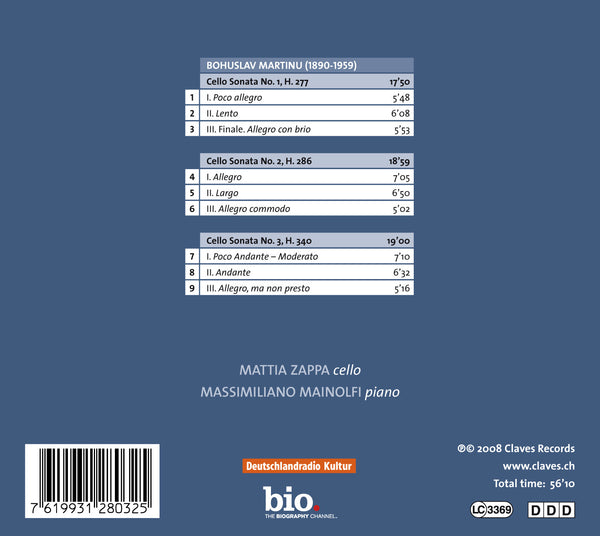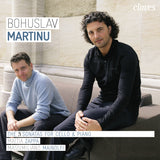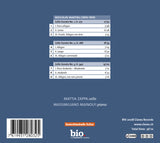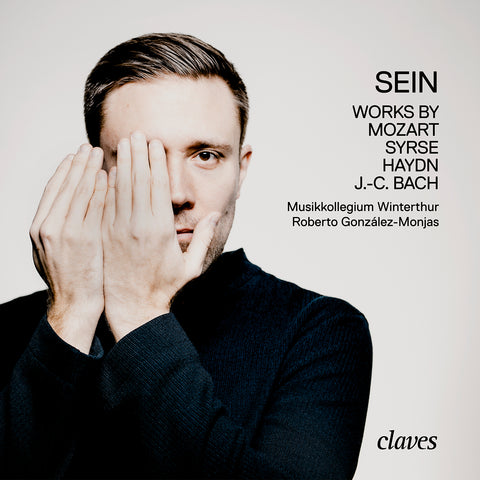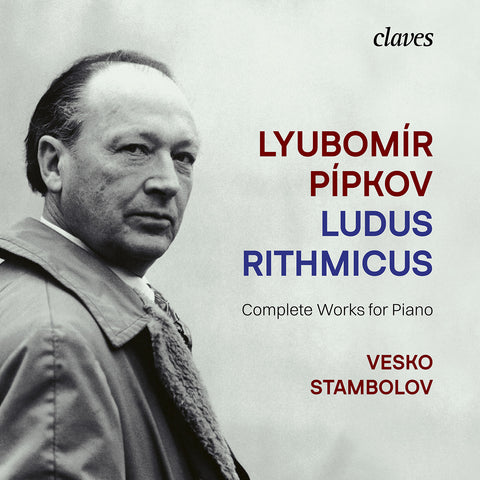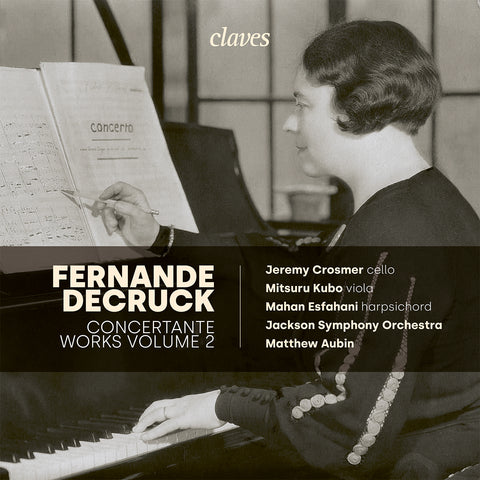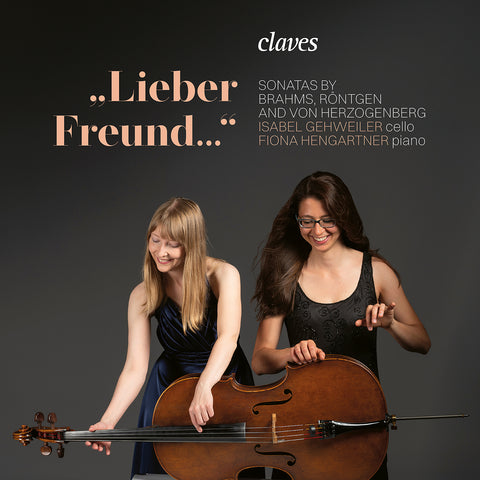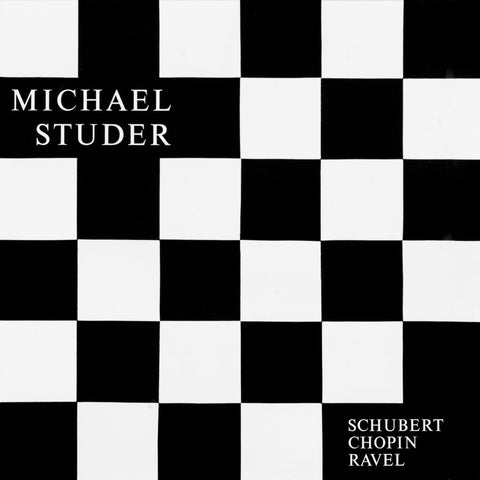(2008) Martinu: The Three Cello Sonatas
Category(ies): Chamber Piano
Instrument(s): Cello Piano
Main Composer: Bohuslav Martinu
CD set: 1
Catalog N°:
CD 2803
Release: 2008
EAN/UPC: 7619931280325
- UPC: 884385783709
This album is now on repressing. Pre-order it at a special price now.
CHF 18.50
This album is no longer available on CD.
This album has not been released yet. Pre-order it from now.
CHF 18.50
This album is no longer available on CD.
CHF 18.50
VAT included for Switzerland & UE
Free shipping
This album is no longer available on CD.
VAT included for Switzerland & UE
Free shipping
This album is now on repressing. Pre-order it at a special price now.
CHF 18.50
This album is no longer available on CD.
This album has not been released yet.
Pre-order it at a special price now.
CHF 18.50
This album is no longer available on CD.
CHF 18.50
This album is no longer available on CD.
MARTINU: THE THREE CELLO SONATAS
« AN ULTIMATE RAY OF SUNSHINE EMANATING FROM A BETTER WORLD »
The First sonata for cello and piano H. 277 is probably the most dramatic of Martinu's chamber music works. It was completed in 1939; shortly after the famous Double concerto for two string orchestras; piano and timpani; illustrating Martinu's reaction to the Munich convention. The political situation was getting worse and worse; and the context in which the sonata was created; on 19th May 1940 in Paris; was even more sombre. The composer was deeply involved in politics at the time and could no longer stay in France; but had to flee from German troops who would undoubtedly have made him prisoner.
The first performance of the sonata was given by two great artists and close friends of Martinu: Pierre Fournier; to whom it was dedicated; and Rudolf Firkušný; a compatriot; who endeavoured to make Martinu's works known in America. Martinurecalls the circumstances of this singular concert: "the effect produced by the sonata was most impressive; no doubt due to its dramatic content and the general atmosphere caused by the war.
It felt like an ultimate salute; an ultimate ray of sunshine emanating from a better world (that was the opinion of the public; not mine). For a few minutes; we all felt the extent to which music could make our lives richer; and we could thus forget the present."
A WORK IMBUED WITH NOSTALGIA
The Third Sonata for cello and piano was written in September and October 1952. Martinustarted it when he was on summer holiday at the Vieux Moulin in France; and finished it upon return to New York.
The sonata is in memory of Hans Kindler; who was a great cellist in Paris before becoming artistic director of the National Symphony Orchestra in Washington; and whom Martinuknew well. Hence possibly its particularly lyrical and nostalgic tone. Nostalgia; however; is also present in other works of that period; as well as in the composer's private correspondence. It arises from personal circumstances and especially from the oppressiveness of the Cold War; which was very much part of the political context of Martinu's homeland.
The following event says it all: the first performance of the Third Sonata was nearly prohibited by the Czech Composers Society; who condemned its cosmopolitan author (an insult at the time). However; František Smetana; who tells the tale; was not intimidated by this; indeed he found an elegant issue by retorting that he would willingly play the works of "young progressive composers" as long as they surpassed Martinu's sonata.
At the beginning of the 1950's; Martinu's musical language becomes more sober. Melodies; reminiscent of Czech or Moravian folklore; are catching. The composer builds them on broken chords or around a central note.
The harmony is also simpler than that of the two former sonatas. The piano concentrates essentially on consonant chord series or homophonic melodies. This capacity to obtain the best effects with simplified composition techniques (such as in the second movement for example) characterizes the whole of Martinu's later works. Ever since its world première; on 8th January 1953 in Washington; the Third Sonata has been one of Bohuslav Martinu's most popular works.
Bohuslav Martinu(1890-1959) was undeniably attracted by the cello. Although the composer played the violin in his youth (with great talent; as mentioned by concert programmes and critics of his native town Policka and surroundings); he wrote many wonderful and instructive pieces for the cello; four with orchestra; and three excellent sonatas. All of them are extremely popular throughout the world.
« AN ULTIMATE RAY OF SUNSHINE EMANATING FROM A BETTER WORLD »
The First sonata for cello and piano H. 277 is probably the most dramatic of Martinu's chamber music works. It was completed in 1939; shortly after the famous Double concerto for two string orchestras; piano and timpani; illustrating Martinu's reaction to the Munich convention. The political situation was getting worse and worse; and the context in which the sonata was created; on 19th May 1940 in Paris; was even more sombre. The composer was deeply involved in politics at the time and could no longer stay in France; but had to flee from German troops who would undoubtedly have made him prisoner.
The first performance of the sonata was given by two great artists and close friends of Martinu: Pierre Fournier; to whom it was dedicated; and Rudolf Firkušný; a compatriot; who endeavoured to make Martinu's works known in America. Martinurecalls the circumstances of this singular concert: "the effect produced by the sonata was most impressive; no doubt due to its dramatic content and the general atmosphere caused by the war.
It felt like an ultimate salute; an ultimate ray of sunshine emanating from a better world (that was the opinion of the public; not mine). For a few minutes; we all felt the extent to which music could make our lives richer; and we could thus forget the present."
A WORK IMBUED WITH NOSTALGIA
The Third Sonata for cello and piano was written in September and October 1952. Martinustarted it when he was on summer holiday at the Vieux Moulin in France; and finished it upon return to New York.
The sonata is in memory of Hans Kindler; who was a great cellist in Paris before becoming artistic director of the National Symphony Orchestra in Washington; and whom Martinuknew well. Hence possibly its particularly lyrical and nostalgic tone. Nostalgia; however; is also present in other works of that period; as well as in the composer's private correspondence. It arises from personal circumstances and especially from the oppressiveness of the Cold War; which was very much part of the political context of Martinu's homeland.
The following event says it all: the first performance of the Third Sonata was nearly prohibited by the Czech Composers Society; who condemned its cosmopolitan author (an insult at the time). However; František Smetana; who tells the tale; was not intimidated by this; indeed he found an elegant issue by retorting that he would willingly play the works of "young progressive composers" as long as they surpassed Martinu's sonata.
At the beginning of the 1950's; Martinu's musical language becomes more sober. Melodies; reminiscent of Czech or Moravian folklore; are catching. The composer builds them on broken chords or around a central note.
The harmony is also simpler than that of the two former sonatas. The piano concentrates essentially on consonant chord series or homophonic melodies. This capacity to obtain the best effects with simplified composition techniques (such as in the second movement for example) characterizes the whole of Martinu's later works. Ever since its world première; on 8th January 1953 in Washington; the Third Sonata has been one of Bohuslav Martinu's most popular works.
Return to the album | Composer(s): Bohuslav Martinu | Main Artist: Duo Zappa Mainolfi









